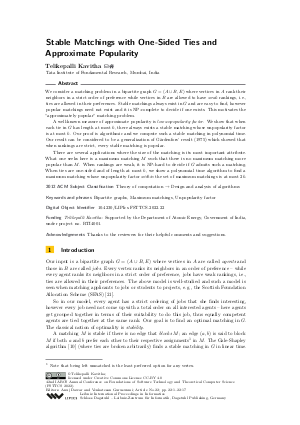@InProceedings{kavitha:LIPIcs.FSTTCS.2022.22,
author = {Kavitha, Telikepalli},
title = {{Stable Matchings with One-Sided Ties and Approximate Popularity}},
booktitle = {42nd IARCS Annual Conference on Foundations of Software Technology and Theoretical Computer Science (FSTTCS 2022)},
pages = {22:1--22:17},
series = {Leibniz International Proceedings in Informatics (LIPIcs)},
ISBN = {978-3-95977-261-7},
ISSN = {1868-8969},
year = {2022},
volume = {250},
editor = {Dawar, Anuj and Guruswami, Venkatesan},
publisher = {Schloss Dagstuhl -- Leibniz-Zentrum f{\"u}r Informatik},
address = {Dagstuhl, Germany},
URL = {https://drops.dagstuhl.de/entities/document/10.4230/LIPIcs.FSTTCS.2022.22},
URN = {urn:nbn:de:0030-drops-174144},
doi = {10.4230/LIPIcs.FSTTCS.2022.22},
annote = {Keywords: Bipartite graphs, Maximum matchings, Unpopularity factor}
}

 Creative Commons Attribution 4.0 International license
Creative Commons Attribution 4.0 International license

























